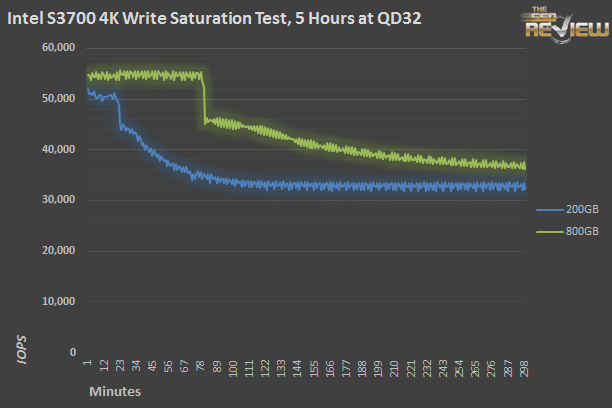ADVANCED WRITE TESTING
Because of the nature of solid state storage, once the drive gets filled, write speed takes a precipitous plunge. We can take a fresh drive and write 4K randoms to it for 300 minutes to see what happens.
To get a feel for the write saturation performance with drives which use deduplication, we run the testing twice; one multi-hour run with zero fill data, and one using random/incompressible data. The lower performance a drive experiences when filled is due to write amplification. As the drive struggles to free up blocks on which to write, tons of additional overhead is incurred.
Each write saturation run took place over a 24 hour period, though we’re only showing the first 300 minutes of that. After all, not much happens over the following nineteen hours, at least in the case of the two Intels. Occasionally, something unusual does happen, or it takes much longer to saturate a SSD (if the drive is particularly slow or unusually large, for instance). It actually takes just about all 300 of those minutes for the 800GB to stabilize, while the 200GB does so in just about two hours.
Just looking at the pair of S3700s, the 800GB is clearly a bit faster. Still, it takes over eighty minutes to fill the drive just once. By comparison, the nearly-as-fast 200GB model fills in just about quarter of that.
Once both drives are crammed to the brim with data, the 800GB manages a steady 36,000 IOPS while the smaller S3700 hangs in at 32,000 IOPS. That’s spot on with Intel’s specifications which trade off the higher fresh-out-of-the-box numbers for persistent performance numbers. That the 200GB fills much more quickly isn’t relevant; a few hours after deployment, all drives will settle into steady state. It is inevitable.
If we take the 800GB’s write saturation run and overlay latency, we see that average latency doesn’t increase by all that much over a fresh state. Latency increases by 67%, instead of several hundred percent. Consequently, the 54,000 IOPS slows only to 36,000, not a mere fraction as with some other drives.
Our stability testing looks great with both Intels. It’s hard for a drive to get much more consistent from one second to the next at steady state. The 70% read/30% write testing fluctuates a bit more, but the grouping is still super tight. And the 100% 4K write is truly spectacular, representing about the most razor-flat results a SATA drive can have. Intel’s new controller design was created with an emphasis on latency, and it does not disappoint. Over provisioning and excellent garbage collection combine to keep performance consistently high when the drive is subjected to long-term, write heavy workloads.
SSDs have fingerprints, just like people in a manner of speaking. The S3700 has a repeating, predictable pattern as the garbage collection and mapping algorithms do their work. Most MLC drives, and even a lot of SLC drives, are too unpredictable from millisecond to millisecond to form any long lasting impressions. The S3700s pattern here is unmistakable.
 The SSD Review The Worlds Dedicated SSD Education and Review Resource |
The SSD Review The Worlds Dedicated SSD Education and Review Resource | 


Awesome product again, but price is very strange its equal to capacity i mean 2x100GB is exactly the same as 1x200GB and so on. For enterprise server more capacity is logical (save power & room), but for mid range servers its a kill – deal to buy smaller drives price/performance it will be a lot more then awesome.
Are you still using IOMeter to generate you test data? Also, are you testing the drive raw, or with a logical file system? Great review!!
On page 5, it’s described that this SSD uses deduplication.. is it right? Because I don’t find Intel has mentioned it elsewhere.. thanks for the great review.